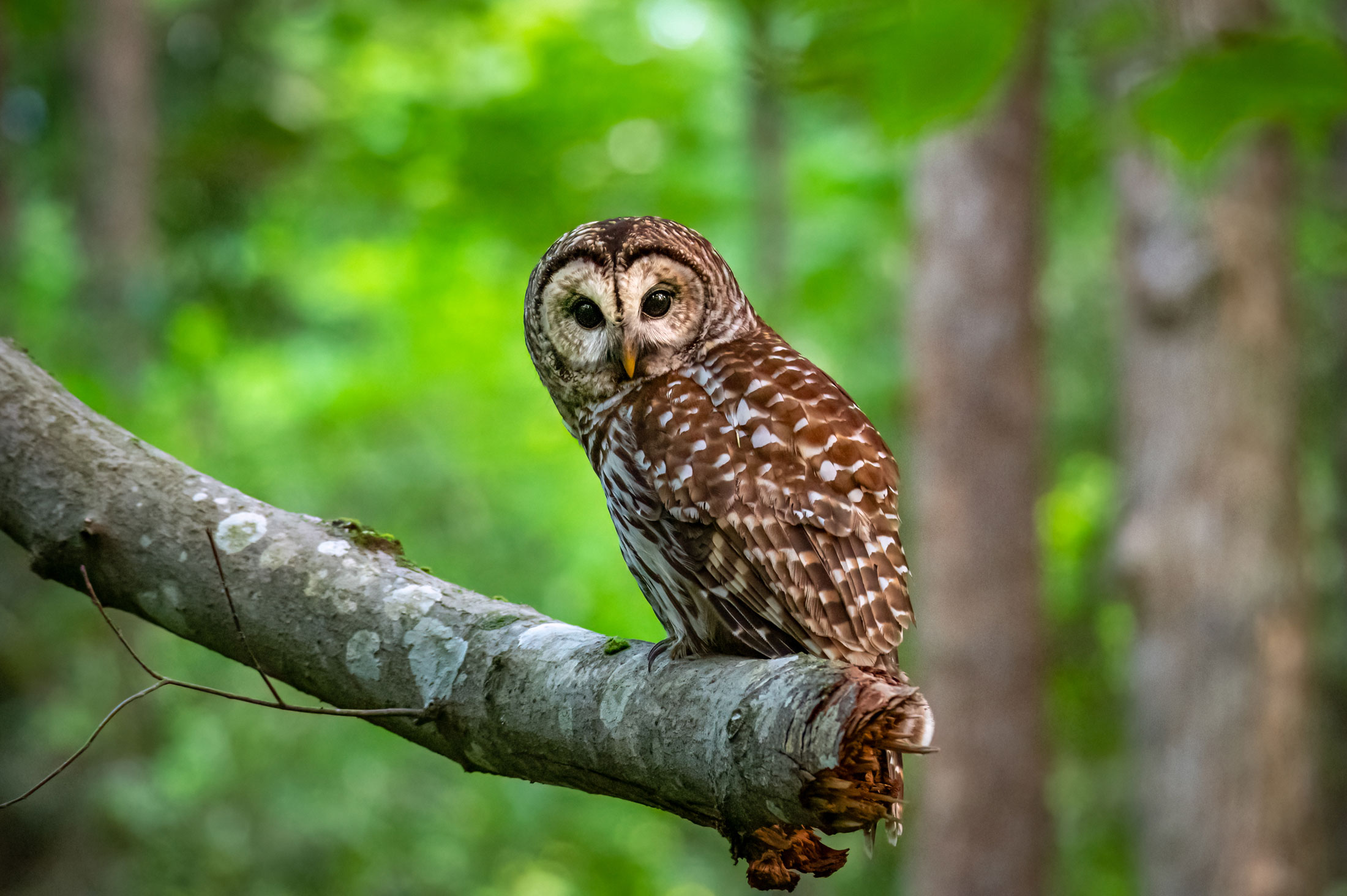
If you have day-hiked in the Smokies, you have undoubtedly been monitored, unawares, from a tree cavity. The unseen watcher? A winged super-predator resting with one eye open, waiting for dusk or nightfall. Though vultures, hawks, eagles, and ospreys rule park skies by day, after the sun goes down, the forest belongs to the owls.
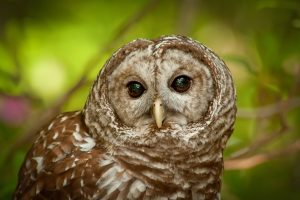
“Rodents and roosting birds are owls’ most frequent meals,” said Tom Howe, who has studied birds at Cornell University’s Lab of Ornithology and is an active member of the Knoxville Chapter of the Tennessee Ornithological Society. “They are well adapted for hunting with their great nocturnal eyesight and special positioning of their ears that enables them to judge the precise direction of sounds.”
Owls’ enormous eyes face forward on the front of their heads, like those of humans—likely the reason we have described them as wise down through the ages. This gives them 3-D or binocular vision for accurately gauging distance and perfectly timing a successful attack. Other visual adaptations include widely dilating pupils that can take in lots of light, even after dark; refined light-sensing retinal cells for detecting movement in low light; and “third eyelids” (called nictitating membranes) that close horizontally from the inside to shield the eye from debris.
“Owls can turn their heads three-fourths of a turn,” Howe said, “but are so fast that they can appear to be able to turn all the way around if you walk around them in a circle. This turning is a necessary trait because their eyes can’t turn in their sockets. So, both their eyes and ears face forward but their heads swivel, unlike other birds.”
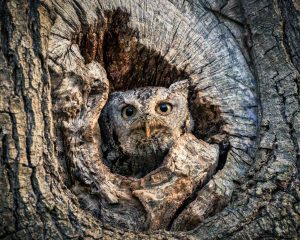
Although owls are always watching us, we may have trouble spotting them—unless we know exactly when and where to look.
“It’s very difficult to see owls,” said Keith Watson of the Southern Appalachian Bird Conservancy, who leads birding trips in Great Smoky Mountains National Park. “But the best way is to hike or drive slowly and watch for perched birds above creeks or along sides of roads where prey may be more abundant.”
Who’s up for the challenge? There are three main owl species you are likely to see.
“The barred owl is our most common breeder in all park habitats,” Watson said. “They can often be heard throughout their range during the day, and they often feed in daytime also. Eastern screech-owl is common everywhere except in the higher elevations, but they do breed here. And the great horned owl is a breeder with generalized habitat throughout the park, but not common.”
Howe said that dawn and dusk are “the favored times” to see owls but coming across them can be hit or miss. A few hours before dawn is often the best time to hear owls or see a great horned owl sitting high on an exposed limb or post.
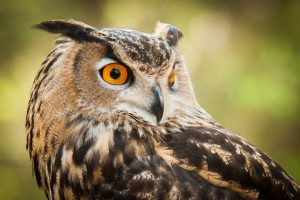
Several species of more northern owls winter in the park but are much harder to see according to Paul Super, park science coordinator based at Appalachian Highlands Science Learning Center at The Purchase.
“Both long-eared owl and northern saw-whet owl are highly nocturnal and pretty quiet in the winter,” he said. “The northern saw-whet owl breeds here and is limited to the high-elevation northern hardwoods and spruce-fir habitat.”
Named for their monotonous call resembling the sound of someone sharpening (whetting) a saw, northern saw-whet owls are considered threatened in both North Carolina and Tennessee. Super noted that while there is only one winter report of a long-eared owl in Cades Cove, the cove has a more frequent, if rare, winter visitor in the short-eared owl.
“They are most often seen at dusk flying low over the fields, especially west of Hyatt Lane,” he said, “but they do sometimes fly during the day, especially during inclement weather. Sunset is the best time to get a glimpse.”
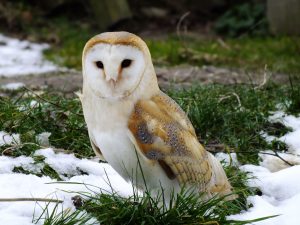
Retired supervisory forester Kristine Johnson remembered a late afternoon in 2012 when she and Susan Hoyle, a fellow member of the Tennessee Ornithological Society, were birding in Cades Cove for the annual Christmas Bird Count.
“Susan and I were cold and wet and were debating whether to walk out into a field off Sparks Lane before we called it a day,” Johnson said. “The rain seemed to slack off a bit, so I joked, ‘Let’s go out. Maybe we will see a short-eared owl.’ This really was a joke because we had never seen one in Cades Cove. I had never seen one anywhere and only thought of it because someone in the bird club had caused great excitement by reporting one in Middle Tennessee a few weeks earlier. We walked a few hundred yards into the wet grass as rain and wind picked up again. And there, perched on a fence right in front of us, was a short-eared owl. When Susan told me what it was, I thought she was joking!”
Back in the late 1990s, Johnson was involved with an attempt to bring one species of owl back to the park. A press release from 1998 announced that “on Monday night, August 24, wildlife managers at Great Smoky Mountains National Park added the barn owl to its inventory of former native creatures which have been reintroduced into the Smokies. A total of seven of the handsome birds, also known as ‘ghost birds’ because of their off-white plumage and silent flight, were released into Cades Cove.”
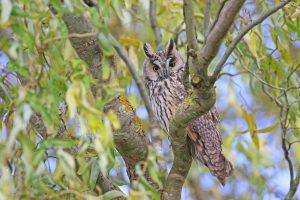
These owls, which prefer open habitats with fields and structures, were part of a park effort to re-establish the native plant and animal communities that existed in the cove during the late 19th and early 20th centuries. The release explains how barn owls “were once common throughout the temperate zones world-wide but have declined dramatically due to the entry of DDT and other pesticides into the food chain.”
The owls’ decline was also caused by changes in land use from grasslands to row crops and a shift from traditional wood-frame barns to modern metal buildings with few ledges for roosting. Since Cades Cove offered old wooden barns surrounded by 2,000 acres of meadow with an abundance of insects and small mammals, it seemed likely barn owls would establish breeding populations.
“I do not know why the barn owls did not succeed in the Cove,” Super said. “Perhaps they did not find a good place to nest. Perhaps the local barred owls caught and ate them.”
Barn owls can disperse hundreds of miles after fledging, so re-introduction and re-establishment are known to be difficult, according to Johnson, who handled owls released in the attempted reintroduction.
“Those we were given from the Knoxville Zoo were rescued from demolition barn sites, so their lives were already in turmoil,” she said. “Barn owls are difficult to detect and monitor because they don’t call on territory and are strictly nocturnal. So, who knows, maybe they are still around Cades Cove.”
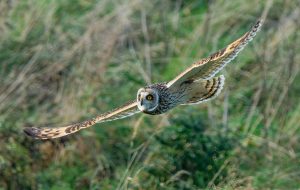
Some owls, including barred and great horned, are crepuscular—active during the twilight hours of dawn and dusk. Visitors hoping to spot owls may be tempted to lure them in by playing their vocalizations. But the park strongly discourages this, because recorded calls are usually territorial.
“If one plays the call of an intruder one time,” Super said, “the bird is not likely to alter its territory or use up a lot of its resources defending its territory from this ‘ghost rival.’ But in a place with millions of visitors, if that mysterious interloper keeps coming back, the bird may be motivated to shift its territorial lines or spend a lot of effort defending its property.”
He recalled once someone played a barred owl call near their tent site, bringing in a barred owl pair. The owls paid back the imposter by “whooping it up over his tent all night long, but that is time they could have spent hunting.”
The biggest threat to owls on non-park lands is habitat loss. Howe said that outside the park, “the easiest way to bolster owl populations is most likely to put out specifically made owl nesting boxes. For helping our largest owl, the great horned owl, preservation of wood lots with large trees is key. They aren’t cavity nesters.”
Another way humans inadvertently threaten owls? Traffic. Roads are a major hangout for insects and rodents—owl food.

“Unfortunately, the reason is likely because people throw food refuse out their car windows,” said Howe. “This attracts mice which in turn attracts these owls.”
Even their visual superpowers and swift flight cannot protect owls from wildlife–vehicle collisions.
“We have a number of roadkills of barred and eastern screech-owls trying to cross the road at night,” said Super. “Just one more reason it’s important for visitors to drive slowly through the park at any hour.”
If you are fortunate enough to capture an image of a barn owl or long-eared owl in the park, please email Paul_Super@nps.gov with the image as well as information about where you encountered the owl and when.
Subscribe to get the latest posts sent to your email.
The Great Smokies Welcome Center is located on U.S. 321 in Townsend, TN, 2 miles from the west entrance to Great Smoky Mountains National Park. Visitors can get information about things to see and do in and around the national park and shop from a wide selection of books, gifts, and other Smokies merchandise. Daily, weekly, and annual parking tags for the national park are also available.